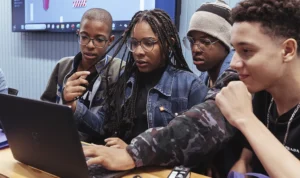The first Impact Report released by iFood also shows the progress of its diversity. The document, published in September, provides an overview of the company's ESG (environmental and social governance) actions between 2021 and 2022 and can be consulted online, in the version complete or in summarized.
This new report brings iFood's main actions and results in the areas of education, environment and diversity and inclusion — the latter will be the theme of this third report in the series.
iFood currently has more than 5,000 employees and purpose of ending the year 2023 with 50% of women in leadership positions (and 35% in senior positions) and with 30% of black leaders (and with 40% of black employees). In the company, leadership positions are those of coordination and superiors, and senior leadership positions are those of head (one level above management) and above.
These commitments, made in July 2021, are aligned with two Sustainable Development Goals UN (United Nations) SDGs: gender equality and reducing inequalities. And in September they were reinforced when the iFood signed the Racial Equity Promotion Pact —in 2020, the company had already signed the Female Empowerment Pledge of UN Women.
In just over a year, objectives in the field of diversity have advanced. By September 2022, the company had already reached the proportion of 18% of black people in senior leadership and 31.8% of women in senior leadership, according to the Impact Report. “Since April this year, we have already managed to have more than 60% of diversity on the list of candidates called for interviews for coordination positions and above”, adds Bel Glezer, from the company's diversity and inclusion team.
Education for diversity
iFood has also been implementing actions that allow the real inclusion of minority groups in the company as a whole, not only with development programs, career acceleration, support and mentoring for minority groups, but also with the literacy of its leaders.
“Leadership development is part of our strategy. For us, it is not enough to empower black people and women. We need leaders who are more aware of their biases when making choices, of their privileges, so that management is more inclusive”, explains Bel.
The company's own employees also help with part of this education process with Pollen, as the set of affinity groups that debate topics related to pollen are called. women, black people, LGBTQIAP+ It is disabled and to free body.
“In addition to our development initiatives, we continue to rely heavily on Pólen in education and engagement on the topic of diversity within the company”, comments Bel. “In these groups, people talk about diversity topics in a safe space and participate in literacy and awareness-raising processes.”
Inclusion indicator
To find out how this inclusion is being perceived by employees, the iFood has an inclusion indicator, the Psychological Safety Index, developed based on the methodology of Dr. Amy Edmondson, from Harvard University.
In this way, it is possible to measure whether people feel in a psychologically safe environment by measuring aspects such as a sense of belonging, freedom to express their identity, to disagree, to take risks and to learn.
“When we created diversity goals, they were linked to this indicator of psychological inclusion. From the first investigation, we already saw a healthy indicator of psychological safety in the company as a whole. And it has already had a very interesting increase: it went from 8.5 to 8.7 on a scale of 0 to 10”, says Bel.
This index is applied throughout the company, and its results are analyzed comparing minority and non-minorized groups, for example women, black people, LGBTQIAP+, transgender and disabled people.
That of cisgender women and men is compared, for example, with that of transgender people, and that of black people with that of non-black people. “We know that the path to diversity and inclusion is long, but from 2021 to now, we have practically eliminated the discrepancies in this index between minority groups when we look at the total iFood population”, says Bel.


